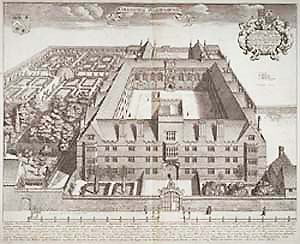David Loggan (1635-1700?) was a Danish engraver who came to live at Nuffield, in Oxfordshire, in 1665. There, he set about drawing and engraving views of the city of Oxford and the colleges and halls of the University, some of which he exhibited in 1669, when he was appointed as the University's engraver. By January 1675, the plates for his work were finished, and by June of that year Oxonia illustrata had been printed. Loggan's plates complemented the Historia et antiquitates universitatis Oxoniensis, written by Anthony Wood, which had been published in the preceding year.
The plate illustrated (overleaf) is number 32 in the volume, Loggan's engraving of Wadham College, dedicated to Dr Giles Strangways. From 1648 to 1659, under the Wardenship of John Wilkins (see catalogue no. 19 ), Wadham was a focus for natural philosophical debate and enquiry. Clearly visible in this engraving are the tower over the entrance to the College, from which Wilkins' young protégé, Christopher Wren (see catalogue nos. 60 and 65), and others made telescopic observations, and, on the left of the picture, the gardens, which Wilkins enlarged and improved. In the foreground are the trees and groves of the Warden's garden, among which a summerhouse can be made out; in the background is the more formal Fellows' garden, which was laid out on land purchased during Wilkins' Wardenship for a total cost of £72-13-0, and has at its centre a mound, surmounted by a figure of Atlas bearing a globe. Climbing the walls of the Fellows' garden are a variety of fruit trees.
Robert Boyle, who was resident in Oxford for a number of years from 1654, informed Hartlib about the 'peculiar Flowers' to be found growing in Wilkins' garden (Hartlib Papers, 29/5/2B [Ephemerides, 1655]). Various features of Wilkins' garden intrigued different correspondents of Hartlib. Several were fascinated by the transparent hives, which Wilkins had built to an improved version of William Mewe's design and in which it was possible to observe a cascade of honey. Others commented on the dials and weathercocks which Wilkins had installed, and on his 'watering instrument', a device (based on a design taken from the Pneumatics of Hero of Alexandria) with multiple spouts, each in the form of a different figure, which was worked by suction and could generate a mist of water over part of the garden. Evelyn remarked on the 'talking statue' which stood in the garden and was operated by means of a concealed speaking pipe. Wilkins grew salad crops and Indian wheat in his garden, which was organized, one of Hartlib's correspondents wrote, according to the view that 'what concernes Naturall Philosophy in generall must not be thought Irrelative to Husbandry, which is but an application of it to rural subjects' (Boyle Papers37). Wilkins' garden was thus a place of improvement and delight, in which learning was harnessed effectively to generate both pleasure and profit. |
Falconer Madan, Oxford Books: a Bibliography of Printed Works Relating to the University and City of Oxford (3 vols, Oxford, 1895–1931), vol. 3, pp.304–8; Charles Webster, The Great Instauration (London, 1975), pp.162–3; D.J. Mabberley, ‘The Gardens’, in C.S.L. Davies and Jane Garnett (eds.), Wadham College (Oxford, 1994), pp.100–21; Royal Society, London, Boyle Papers37 (Letter to Hartlib, 14th September, 1655); HartlibPapers,28/1/70A,29/5/2B,29/6/19A,33/1/23A–26B, 70/6/1A–2B.
|




